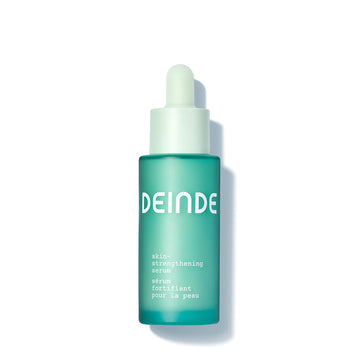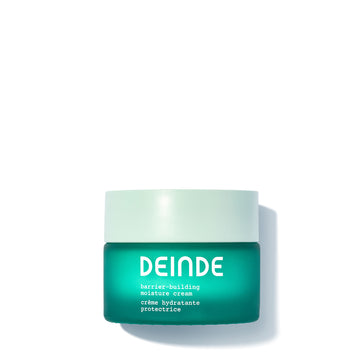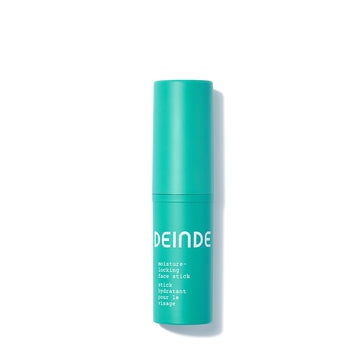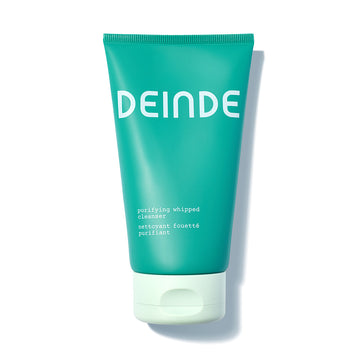
How Long To Wait Between Each Skincare Step
Skincare, in its essence, is the direct nurturing of the body’s largest organ. As you cleanse, moisturize, and apply supportive products day after day, you’ve likely found yourself wondering:
- What's happening beneath the surface?
- How long should I wait between each product to ensure optimal impact?
- Is it better to layer everything, everywhere, all at once, assuming that ingredients will get where they need to go?
DEINDE encourages this relentless commitment to learning good practices — these questions are the least we can ask of the products that we’re putting on our skin for days, years, and decades to come.
That’s why DEINDE came to be after all: exploring how we can leverage beauty biotech to target inflammaging, now viewed by scientists as the root cause of aging.
How long should you wait between skincare steps?
The correct order goes lightest to thickest, with the lightest products being applied first. This helps your skin make the most of all of your skincare ingredients.
When it comes to the ideal waiting period for key skincare products, here’s what we generally recommend:
- Cleanser → Used for gentle removal, cleansers are formulated with surfactants that break down and lift away dirt or pollutants on the skin. When a cleanser is massaged onto the skin and rinsed off, it purifies the epidermis. Cleansers are used on the skin’s surface to create a clean canvas for the application of other products
Because cleansers work on the skin's surface and are rinsed off quickly, there's no need to wait here long
- Exfoliants → Remove dead skin cells from the skin's surface. They can be chemical exfoliants, like alpha hydroxy acids (AHAs) or beta hydroxy acids (BHAs), which dissolve the bonds between dead skin cells, or physical exfoliants, such as scrubs, which manually slough off these cells, promoting skin renewal and a smoother complexion
Ideally, allow an exfoliant to sit for 5+ minutes to break down dead skin cells, unclog pores, and prompt skin renewal before proceeding with your skincare layering
-
Toners → Balance the skin's pH levels and remove any residual impurities after cleansing. They are typically absorbed quickly by the skin, providing a refreshed and hydrated base for the application of subsequent skincare products
For toners, a waiting time of up to a minute before applying the next product allows the skin’s pH levels to balance, creating an ideal environment for serums and toners
-
Moisturizers → Are generally formulated with larger, emollient-rich ingredients like oils and humectants, that help create a protective barrier on the skin’s surface. When moisturizer is applied, it forms a sort of film that traps moisture within the skin and prevents any additional water loss
A good rule of thumb is to wait at least 30 seconds to allow for a moisturizer to form a protective barrier and lock in skin’s moisture
- Serums → Are formulated with smaller molecules and higher concentrations of active ingredients, allowing them to penetrate the skin more deeply. This efficient absorption helps them target specific skincare concerns effectively and deliver visible results
When applying a serum, wait at least 30 seconds to a minute before layering. It’s beneficial to allow active ingredients enough time to effectively penetrate the epidermis without diluting the formulation - Sunscreen → SPF formulations are composed of active ingredients that act as physical blockers. They work by forming a barrier that reflects or absorbs, protecting the skin against harmful UV rays
Let set for a few minutes — sunscreen should be the final step in a skincare routine. It’s vital that sunscreen forms a protective barrier on the skin’s surface, so applying anything right after will be detrimental
What is the science of skincare absorption?
Epidermis
Any product you apply will initially touch the outermost layers of the skin — the epidermis. The stratum corneum, the outermost layer of the epidermis, is composed of dead skin cells within a lipid matrix and acts as a barrier to prevent water loss and protect the skin against any external threats.
On Absorption: The epidermis is recognized for its controlled absorption. The outermost layer of the epidermis, the stratum corneum, is composed of stacked, flattened cells (corneocytes) bound together by a mixture of lipids (ceramides, cholesterol, free fatty acids)
At the same time, the epidermis has the capacity to develop what is known as the “reservoir effect” — this is when a substance stays and accumulates on the skin. The stratum corneum contains natural moisturizing factors (ex. amino acids, lactic acids) and a range of enzymes, which influence the controlled absorption of substances based on the skin’s current hydration and pH levels. When skin is at optimal levels of hydration and pH, it is more receptive to absorb skincare products — this is why applying your products on damp skin is often touted as a skincare tip.
This lipid matrix is the predominant barrier for product permeation — it functions as a hydrophobic shield to block water-soluble compounds and welcome lipid-soluble molecules. To translate, skin is generally more friendly to lipophilic molecules, which can allow better absorption of facial oils and certain moisturizers.
Dermis
While the initial contact point for a skincare product is the epidermis, the underlying dermis plays a unique role in the absorption process. The dermis is the second major layer of the skin beneath the epidermis and plays a vital role in the absorption and processing of skincare products. It's a dense, connective tissue layer that houses blood vessels, hair follicles, sweat glands, and collagen and elastin fibers, providing structural support to the skin.
On Absorption: Products like serums, moisturizers, eye creams, and treatments can penetrate the dermis, where they can have a more profound impact on the skin's health and appearance. The dermis, composed of collagen and elastin fibers, provides structural support and elasticity to the skin
Formulations that include ingredients targeting collagen and elastin production interact directly with these vital fibers in the dermal layer. For example, peptides and retinoids like retinol are known to help support proper collagen production, promoting firmer and more resilient skin. The elastin-rich environment of the dermis ensures that skin has the ability to stretch and contract, an ideal environment for products designed to improve skin elasticity and suppleness. Additionally, the vasculature (network of blood vessels) within the dermis helps distribute vital nutrients and oxygen to skin cells, allowing the transport of active ingredients from skincare products to various regions of the skin.
Subcutaneous Tissue
Beneath the dermis lies the subcutaneous tissue, the deepest layer of the skin. While it may not be directly involved in the absorption of skincare products like the dermis and epidermis, subcutaneous tissue plays an essential role in the overall health and appearance of the skin. Composed primarily of fat cells, this tissue serves multiple functions, including insulation, cushioning, and energy storage. This layer contributes to the skin's plumpness and contour, indirectly influencing its texture and appearance.
Product Absorption: It's worth noting that skincare products, such as serums, moisturizers, and treatments, are primarily absorbed by the dermis and epidermis, meaning penetration into the subcutaneous tissue is limited. The subcutaneous tissue, primarily composed of fat cells, serves functions like insulation and cushioning, rather than actively participating in the absorption of these product
Studies cited:
- Comparison of Human Skin or Epidermis Models with Human and Animal Skin In-Vitro Percutaneous Absorption | International Journal of Pharmaceuticals
- Skin Aging and Skincare | Springer Link
- The Relation of pH and Skin Cleaning | Current Problems in Dermatology
- The Impact of Skin Care Products on Skin Chemistry and Microbiome Dynamics | BMC Biology









